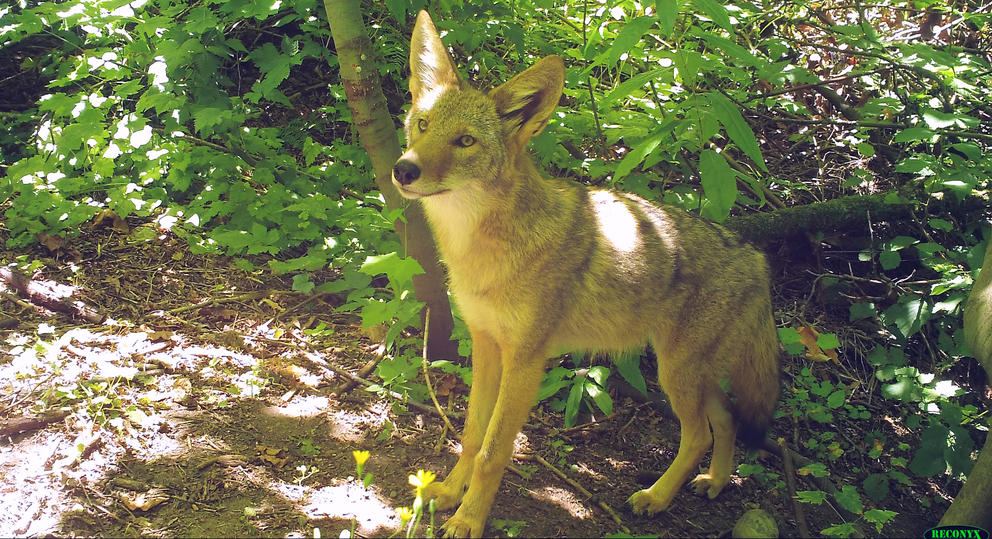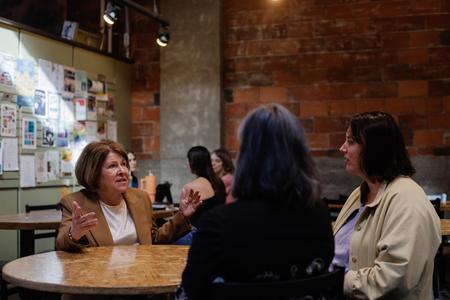Podcast | Tracking the wildlife in Washington cities and suburbs
During the pandemic, more people are spotting animals slinking around the neighborhood.

A coyote captured in the region by Seattle Urban Carnivore Project camera traps. (Seattle Urban Carnivore Project)
It’s no secret that Washington state is home to many charismatic carnivores — wolverines, bobcats, cougars and bears (oh my!). But it might come as a surprise that plenty of them live in our backyards, literally.
For years, healthy populations of coyotes, raccoons, bobcats and otters all have resided within Seattle city limits, while cougars and black bears haunt the suburbs and exurbs (though sometimes a cougar finds its way into Discovery Park). But with the pandemic drastically increasing the amount of time we spend near our houses, more and more people are spotting these animals slinking around the neighborhood.
Now scientists want your help to understand the carnivores among us. The Woodland Park Zoo and Seattle University have teamed up to create the Seattle Urban Carnivore Project to track the animals, and anyone can participate using the Carnivore Spotter app.
We talk to wildlife biologists and project leaders Mark Jordan, Robert Long and Katie Remine to better understand why these creatures thrive in the big city, and how we can safely share the urban habitat we all need to survive.
Subscribe to Crosscut Escapes on Apple Podcasts, Stitcher, Podbean or Overcast.
Complete transcript:
Anonymous speaker: [00:00:00] This episode of Crosscut Escapes is presented by Forterra. Land for good.
Ted Alvarez: [00:00:10] Okay. Let's see here. I'm heading into the alley where I saw it go. K.
Oh. Hang on. There it is. Just a second. Let's see,
Oh. It's a cat. It's definitely a cat. Here, kitty, kitty.
Hello listener. Welcome to Crosscut Escapes. I'm your host, Ted Alvarez. And I want to show you something.
The other night I went out into the wild in search of carnivores, but I wasn't out in the mountains or some wind-swept beach. I was in my backyard and a few neighbors' yards and streets, and finally, an adjoining alleyway looking for a coyote. A few months ago, someone in my neighborhood had printed out and posted a homemade sign on a telephone pole on a corner near my house.
In big Helvetica font it said "Coyotes in area. Be careful." Afterwards someone, neighborhood kids probably, had a lot of fun with it, printing out competing signs: "T-Rex in area. Be careful," "Vampires in area. Be careful." The neighbor didn't take kindly to that and posted another sign that said something like "You are stupid. This is serious." People have a lot of downtime in a pandemic.
But the truth is, the worried neighbor was probably right. We do have coyotes in Seattle, and raccoons, even otters. We even have the occasional cougar. Just this past December, there was a credible sighting in Discovery Park. In 2009, there actually was a cougar in the park and wildlife officials had to tranquilize it and release it back into the wild.
Since I saw that sign, I've kept my eyes peeled and every once in awhile, I go out and search for these charismatic wild animals. Seattle, it turns out, is a great place to do that.
Robert Long: [00:02:42] Seattle, the Emerald City. It's named that for a reason. It's green here. It's lush. Things grow.
Ted Alvarez: [00:02:49] This is Robert Long. He's a senior conservation scientist at the Woodland Park Zoo.
Robert Long: [00:02:54] The fact that we have quite a few parks and forested areas, combined with shorelines, bluffs and cliffs, forests, hills right in the city. So there's quite a diversity of habitat types here. To have the parks chained together in some ways allows animals to maybe find refuge among a sea of humans. So, we are close to really wild landscapes.
It's a pretty steep gradient from urban-suburban to truly wild. You can drive 15 minutes from the University of Washington campus and be in a place where you could see a bear or a cougar.
Ted Alvarez: [00:03:35] If you've ever been to those wild landscapes, you know how rare sightings of those creatures can be. Being elusive as part of what makes them successful. That extends to the city.
Right now, for example, we don't know exactly how many coyotes there are in the Seattle area, but scientists like Robert Long and Mark Jordan wants to find out. Here's Mark, an associate professor of biology at Seattle University.
Mark Jordan: [00:03:58] I got started in wildlife doing field work in the Southern Sierra, studying fishers, which is a big weasel. I spent a lot of my career studying very wildland, far away, kind of critters, and when I came to Seattle University, about eight years ago, I decided I really wanted a project that would be focused more locally that I could really easily do with undergraduate students where we could go from campus to the field and back, say, in an afternoon.
And that's really what drove me into urban wildlife, but I've always been interested in carnivores Robert Long, who also studied fishers, he and I crossed paths kind of multiple times professionally. And then we wound up moving to Seattle around the same time. And we've been talking to each other for quite a while about putting together a project.
And we finally honed in on this idea of doing an urban wildlife camera project.
Ted Alvarez: [00:04:51] Joined by the Woodland Park Zoo's conservation coordinator, Katie Remine, the Seattle Urban Carnivore Project was born. The goal was to understand how certain key species -- black bears, bobcat, cougars, coyote, possums, raccoons, river otters, and red foxes -- interact with their human neighbors. To do that, the scientists and a network of volunteers deployed camera traps to wildlife corridors, parks and neighborhoods all over the greater Seattle region. But with only a few dozen cameras to use, the team realized they needed more eyeballs. So shortly before the pandemic, they launched Carnivore Spotter.
Mark Jordan: [00:05:27] As long as you have a smartphone or a desktop computer, you can participate. If you see a carnivore and you're just out and about in the Seattle area, you can, right then at the moment or later on, you can go to the website, carnivorespotter.org, and just click on the button to submit a report. And then there's a form that walks you through.
You can set the location where you identified the species, you can put what you think the species was. There's other information about what you were doing. Cause we're also collecting a lot of information about the animal's behavior and their interactions with us. So, for example, how big was your group? Were you walking a dog? Those sorts of things. Then there's also an option to upload a photo or a video.
And it's really great when people include photos and videos, because then we can verify the identifications and really be certain that what people said was a coyote is actually a coyote and maybe not the neighbor's dog.
Ted Alvarez: [00:06:27] Of course, sometimes it is the neighbor's dog, or cat, in an alley, but with thousands of Seattleites now deputized as citizen scientists, the teams started to learn some interesting things about the carnivores among us.
Mark Jordan: [00:06:39] One of the things that's really interesting is we have this sort of, as you move from the East to the West -- so we extend out to east King, Snohomish, Pierce counties in the foothills -- and you see the big carnivores, you'll get a few sightings of mountain lions, you get a lot of black bear sightings and bobcats, and as you move west, they slowly, one-by-one, disappear.
So, first the cougars drop out, then the black bears, then the bobcats. And then the coyotes are pretty much constant, throughout, which I thought was very interesting in that we get lots of coyote sightings in North Seattle and other parts right here in the city. So, it's the sort of thing you would predict just knowing these species, but it's really interesting to see it on a map, very visibly laid out and clearly that that transition really is happening.
And then we do sometimes get some cool interaction videos. We've got one short video of coyote and a black bear playing with each other, which is really pretty wild. And another one of a, sort of a coyote in what looks like kind of a place dance with a big mean cat in the backyard. And eventually the cat expresses its dominance and the coyote takes off.
There's some species that we almost never see with the naked eye, like a bobcat.
But sometimes the technology at our doorstep can show us that they're here.
Katie Remine: [00:07:57] I think bobcats are more widespread than people might expect. Because we only started this kind of more spotter a year and a half ago, I don't know how this has changed over time, but a lot of our photos and videos are doorbell cams, like Ring or Nest or whatever.
Like tons of bobcats and coyotes at the back door. And so I think, I wonder if those have increased people's awareness of some of the wildlife around them as well. Certainly a lot of the bobcat sightings are from those.
Ted Alvarez: [00:08:31] Here's Robert again.
Robert Long: [00:08:33] Researchers that do camera trap work, we live for seeing the photos and the reports, and we don't get to see animals most of the time except on these images.
So it's always a treat to look through them. We've had bobcats on sheds and coyotes walking by really blue swimming pools in people's backyards, coyotes playing with either dog toys or kid toys out in the woods that they've stolen.
Ted Alvarez: [00:08:59] We'll be back with more wily coyotes after a message from our sponsor.
Anonymous speaker: [00:09:04] It takes work to sustain a place for all of us. For over 30 years, Forterra has been doing that work, taking action to promote resilient communities and healthy ecosystems across our region. From planting thousands of trees each year, to developing attainable housing, to helping conserve over 250,000 acres of land, the Washington-based land trust has built programs and partnerships to advance conservation, restoration and community resiliency across the state. For more information, go to forterra.org.
Okay. Back to the show.
Ted Alvarez: [00:09:45] Since the carnivores spotter program began, the public has contributed over 5,000 reports. That's in addition to the camera traps operated by 60 to 70 volunteers. And while we've learned a lot about our furry neighbors, plenty of mysteries remain. Foxes, for instance, seem to have disappeared from the city, perhaps crowded out by dominant coyotes. But Robert says they can co-exist elsewhere. Sometimes, you aren't even sure what the animals are eating.
Mark Jordan: [00:10:09] One of the things we're really interested in is, what are these species actually eating when they're in the city. We're trying to figure that out for coyotes right now. Are they actually helping the city with pest control? Seattle is pretty notorious for having a lot of rats, and, so, are these coyotes helping out with this or are even raccoons helping out with this?
Ted Alvarez: [00:10:30] What coyotes actually eat brings us back to the beginning. The neighbor who posted the coyote warning, who motivated me to go in search of urban carnivores. They did so presumably out of fear, a fear that this wild predator would attack them or a loved one or a pet.
But when it comes to coexisting with urban carnivores, whether that's coyotes or raccoons, safety is usually up to us.
Robert Long: [00:10:52] I think the first thing is really understanding and acknowledging that fear that certainly you can feel threatened by it, knowing that there's these wild animals out there, that there's this uncertainty around how this animal is going to behave and understanding that's where people are coming from.
And then helping community members develop the understanding around what are some behaviors that humans can use to really minimize those risks. How can we prevent coyotes from getting habituated to being around us? How can we keep our pets safer.
Please don't feed coyotes or any other wild animal, because that leads to problems. It's best to keep your cats indoors. That's also better for birds. And when walking a dog, always make sure it's under control and on a leash. And I think if you do those few simple things, you really dramatically reduce the risk of any sort of dangerous interaction you would have with these species.
I think the other part of it is just trying to really develop some empathy and understanding for these wild species that are really just responding to habitats we've created that they like. We've created a situation where, if we're leaving food or easily accessible, garbage out, they're going to come find it.
It's really our behaviors and our manipulation of the habitat that sets up these interactions. So we need to figure out ways to better co-exist with these species so that we reduce the negative interactions that we have with them.
Katie Remine: [00:12:11] And it's about respecting each other's space. So there's some space that's people space, like my little backyard is people space. And so it's helping the wildlife understand that as well as respecting their space.
With coyotes, there's two things. One is, especially if going out on the trails, keeping dogs and your pet dogs on a leash or under strong voice control, because, most often, if someone's going to have an issue with a bear or coyote, it can start with an unleashed dog starting an altercation and then bring it back to the person.
If people are in their neighborhoods and they see a coyote in a place that makes the person feel uncomfortable, there's this technique called humane hazing, and it's as simple as shouting clapping, yelling, rattling something metal like your car keys or something like that, just making the coyote a little uncomfortable so that it recognizes that it needs to move off as well.
There are some cases, like if coyotes have a den, they will pay attention to people that are around there, and people often interpret that as, as aggressive behavior and really the coyote is keeping an eye on people, making sure they don't get too close. But it can come off, can feel to the person as as an aggressive behavior. And in that case, it's best just to steer clear of that area, if possible.
THe Seattle Urban Carnivore Project has big plans to reach more people in the future, to fill in blank spots on the map and reach new communities who may or may not know about the fascinating creatures that surround them.
Mark Jordan: [00:13:48] One thing we've noticed with carnivore spotter data is we have what we would call hotspots, where we're getting a lot of reports and then cold spots where we're not getting as many reports. And our thinking within the project is that's not necessarily because there are more animals in some areas and fewer in others it's that there aren't as many people reporting. And so we've used that as a cue to do more outreach and engagement in communities, particularly in South Seattle and South King County, where we don't see as many reports, but just based on what we know about the habitat and the species that probably are just as many individuals out there.
So we're going to do more community-based engagement to see what local community groups in those areas are thinking about wildlife, if they're interested in wildlife, if they're interested in participating in the project in any way, Real long-term, we want, when someone posts on Nextdoor, their Nextdoor listserv or Facebook and says, "Ah, there's a coyote in my backyard," we want their neighbors to reply and say, "Here are the facts. Here's how you can deal with that. It's not a big deal."
And then also just to get people excited about nature and carnivores so that when it comes time to, just supporting public land conservation so that we can have more wolverines in the back country, people understand why that's important and they'll support it.
Ted Alvarez: [00:15:02] As humans, it's easy to think of us as separate from the wild, as though we're the built world begins, the feral parts of the natural world cease to exist, except in rudimentary form. But we might be the only living things that imagine the world that way, and our urban carnivore neighbors are here to remind us, in fleeting thrilling moments, that there's another way to think about wilderness.
Katie Remine: [00:15:24] If we don't think about wildlife and people in a matrix, interlaced together, then we're not going to be able to save wildlife, because if we just protect some pieces of land, not all the species are going to be able to survive.
Ted Alvarez: [00:15:45] That's it for this week's episode. Many thanks to Katie Remine, Robert Long and Mark Jordan. You can learn more about the Seattle Urban Carnivore Project at carnivoresspotter.org.
This episode was engineered by Karalyn Smith, music by the Explorist. You can subscribe to Crosscut Escapes on Apple Podcasts, Stitcher, or wherever you listen.
For more on Crosscut Escapes, go to crosscut.com/escapes. And if you liked the episode, please review us. It helps other people find us.
Crosscut Escapes is a product of Cascade Public Media.
I'm Ted Alvarez. We'll be back with another episode next week.



